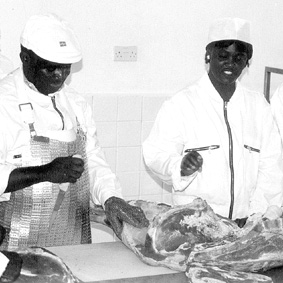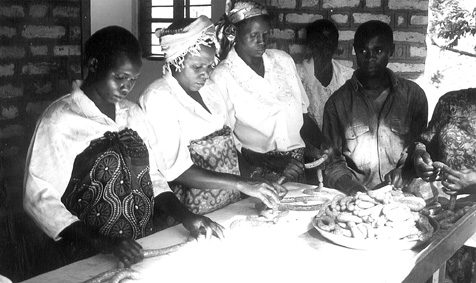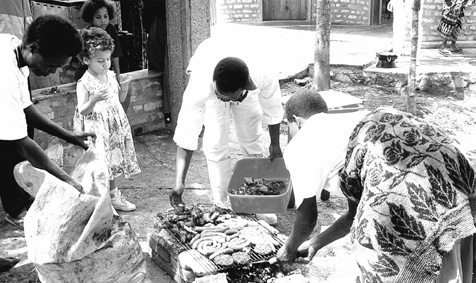


A. Bennett
The author may be contacted at: Animal Production Service, Animal Production and Health Division, FAO, Viale delle Terme di Caracalla, 00100 Rome, Italy. E-mail: anthony.bennett@fao.org
Note: The Development and Promotion of Value-added Meat Products in sub-Saharan Africa project was funded by the Common Fund for Commodities, FAO, Centrum Internazionale für Migrazione and the Government of Uganda. For more information, contact Mr Abel Kaahwa, National Project Director, Uganda Industrial Research Institute, Plot M217, Jinga Road, Kampala.E-mail: phvamp@swiftuganda.com; Tel: +256 41 286124; Fax: +256 41 250579 (c/o FAO Representation).
Un projet mis en œuvre par la FAO, qui a été une grande réussite, GCP/UGA/033/CFC «Mise au point et promotion de produits à valeur ajoutée à base de viande en Afrique subsaharienne», a des effets réels sur le terrain en Ouganda. Il a été mis en place pour favoriser le développement du secteur de la transformation de la viande grâce à la fourniture d'une installation pilote, d'une aide technique et à la formation du personnel et des entreprises intéressées du secteur de la viande dans la région. Aujourd'hui, l'installation pilote est en place et elle a été louée à une société ougandaise privée. L'équipe du projet a élaboré et est en train de mettre définitivement au point 10 produits à base de viande à faible coût et à valeur ajoutée. Quatre cours régionaux de formation destinés aux bouchers et aux chefs d'équipe ont été organisés et le dernier se tiendra en juin 1999. Le projet opère en étroite collaboration avec des groupes locaux de femmes, des associations d'agriculteurs, des groupes de développement rural et des ONG nationales et internationales.

Hands-on training in a regional training course in meat processing, organized under FAO's
Technical Cooperation Programme
Formation pratique au troisième cours régional de formation du PCT de la FAO pour la transformation
de la viande
Prácticas en el tercer curso regional de capacitación en la elaboración de la carne del
Programa de cooperación técnica de la FAO
Photo/foto: p. hautzinger
Un proyecto que ha llevado a cabo la FAO con éxito, Fomento y promoción de los productos cárnicos de valor añadido en el África subsahariana, está teniendo importantes efectos en Uganda. El proyecto se concibió para promover el crecimiento del sector de la elaboración de la carne mediante el suministro de una instalación piloto, la prestación de asistencia técnica y la capacitación de personal y de elaboradores de carne de la región. La elaboradora ya se ha montado y se ha alquilado a una empresa ugandesa privada. El equipo del proyecto está terminando de preparar 10 productos cárnicos de bajo costo y valor añadido. Se han impartido cuatro cursos regionales de capacitación para carniceros y personal de supervisión, y el curso final se celebrará en junio de 1999. El proyecto colabora estrechamente con grupos de mujeres locales, asociaciones de agricultores, grupos de desarrollo rural y ONG nacionales e internacionales.
Development and Promotion of Value-added Meat Products in sub-Saharan Africa is a highly successful FAO-implemented project that is having a strong impact in Uganda. For example, following a two-day village workshop, organized by the project through the Uganda Small-Scale Industry Association, the Nazigo Women and Youth Food Processing and Development Society set up a processed meat products stall at Uganda's national Agricultural Show in Jinga.
The Nazigo society was able to mobilize its resources quickly to take advantage of the existing market outlet at the Jinga Agricultural Show, where sales exceeded all expectations. A former local member of parliament, Mrs Victoria Sebagereka, assisted the group in organizing its activities and promoting its products. The stall was visited by the President of Uganda, His Excellency Yoweri Museveni, who expressed his pleasure at seeing the meat-processing sector expand. In addition to managing their stall effectively, the group also engaged in some more aggressive marketing activities in nearby social clubs.

Hand grating sweet potato - an ingredient added to meat sausages
Râpage manuel des patates
Rallado manual de batatas
Photo/foto: p. hautzinger
The goal of this FAO-executed project (GCP/UGA/033/CFC) is to demonstrate that simple and sustainable processing methods can be employed to produce low-cost, shelf-stable meat products that are affordable to lower-income groups. For this purpose, a pilot meat-processing plant has been set up at the Uganda Industrial Research Institute in Jinga and is leased to a private Ugandan company. A long-term development objective is for the plant - to be known as the Meat Technology Centre (MTC) - to become completely self-sustaining. Specific and in-depth training is currently available at the pilot plant, and small fees are charged for the training of entrepreneurs.
The project's more immediate objectives are to:
· contribute to the supply of processed meat products that suit local tastes, are
relatively cheap and supplement the protein content of the local diet;
· provide a working example of the plant and technology needed for local, national
and international supply of value-added meat products;
· contribute to socio-economic and industrial development through market development
and training necessary to promote small-scale industries producing value-added meat products and upgrading meat
by-products for the domestic market;
· impart the necessary information and skills to the meat industry and interested
parties through effective train-ing and dissemination.

Mincing the mixed sausage ingredients
Hachage des ingrédients mélangés
Trituración de los ingredientes mezclados
Photo/foto: P. Hautzinger
To date, the project has conducted three out of seven planned national workshops and has made contact with a number of NGOs, producers' groups (e.g. the National Farmers' Association), local development organizations, stakeholders in private industry and international development organizations. Since activities are targeted at rural areas, it is essential for the farming community to participate in training so as to receive exposure and to see the advantages of meat processing in real terms. In the near future, MTC will also organize both general and customized training programmes in meat processing for a small fee.

Portioning the sausages
Répartition des produits en portions pour la fabrication de saucisses
Distribución de los productos de las salchichas
Photo/foto: P. Hautzinger
Many interested entrepreneurs have already approached project staff with regard to markets for the processed meat products. Since January 1997, the project team has visited many parts of the country, including Kabale, Fort Portal, Rukungiri, Mbarara, Masaka, Kapchorwa, Bushenyi, Kisizi, Soroti, Hoima, Masindi and Jinja, to assess consumer acceptability and conduct market research. All regions were found to have a high demand for processed meat products. A clear preference was expressed for fresh grilling sausages, meatloaf and blood sausage, and a number of prospective buyers were identified such as restaurants and small commercial centres as well as households.
Why produce processed meat products?
To generate income. Normally 1 kg kilo of meat costs U Sh 1 600-2 200; if the meat is processed efficiently, the return can be as high as U Sh 7 000/kg. Even taking into account hidden costs, such as equipment, energy and water, there are still significant opportunities in the meat-processing sector in Uganda and in the region overall.
To improve nutrition. Boiling and simmering meat for long periods results in a loss of protein and the breakdown of essential vitamins and minerals. Because processed meat products can be sliced and cooked in a shorter time, they often have a higher nutritional content and are more environmentally friendly. Moreover, their contribution to food security is potentially huge.
To achieve equal distribution. If the price of meat products is reduced - and this is one of the main objectives of the project - more people will have access to animal protein and there will be a more equal distribution among children and others in the family, again contributing to an improved nutritional level in the population.

Grilling a variety of processed meat products
Cuisson des produits sur un grill local
Cocinado de productos en una parrilla br>
Photo/foto: P. Hautzinger
It is internationally recognized that insufficient attention has been given to livestock products and their development in the region, where meat-marketing systems are largely based on early-morning slaughter for daily sale. Leftover meat is largely wasted and spoilage sets in quickly. Little initiative has been taken in the development of the meat processing industry although the earning potential for small-scale processing is very high. Current practices result in a high level of post-slaughter losses of up to 20 percent and the poor hygienic conditions associated with these practices also represent a significant public health hazard. Although prolonged cooking times can reduce this hazard, there is concurrently a high loss of essential animal protein and vitamins. The environmentally friendly methods being promoted through the project will also greatly reduce the significant organic waste load (e.g. through use of viscera), which is currently a feature of slaughtering facilities, particularly in rural areas.